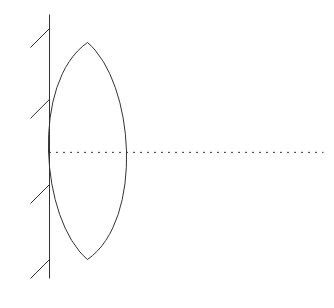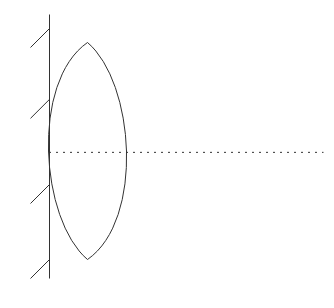
A thin convex lens of focal length 'f' is put on a plane mirror as shown in the figure. When an object is kept at a distance 'a' from the lens - mirror combination, its image is formed at a distance $\dfrac{a}{3}$ in front of the combination. The value of 'a' is:-

A. 2f
B. $\dfrac{3}{2}f$
C. 3f
D. f

Answer
557.4k+ views
Hint: Lens are the things which will allow the light to pass through them with convergence or divergence. Depending on whether the lens will converge or diverge the rays they are divided into convex and concave lenses. Their capacity of convergence or divergence is given by power of the lens. When the mirror is nearly attached to the lens the power will be doubled. Based on this we will solve the problem.
Formula used:
$\eqalign{
& P = {P_1} + {P_2} \cr
& P = \dfrac{1}{f} \cr} $
Complete step by step answer:
The main difference between the lens and mirrors is there are many ways to change the effective focal length of a lens without varying them geometrically. For example if we put the lens in a different medium from air then the refractive index in that medium will be different from that of air. This is not possible for mirrors. They have constant focal length and don’t vary with the medium.
This is because the rays will suffer refraction in the lens and that refraction depends upon the surrounding medium and the entering medium. In case of mirrors there will be no refraction hence the focal length of the mirror won’t change.
Power of the lens is given by the inverse of the focal length. When two lenses are brought very close to each other then their powers will add up and focal length will vary and we get effective focal length of the new lens.
Similarly if we bring a plain mirror very near to the lens then the rays first refraction occurs then reflection from mirror occurs then again refraction occurs. Hence refraction occurs twice. So power will double.

$\eqalign{
& P = \dfrac{1}{f} \cr
& \Rightarrow \left| P \right| = {P_1} + {P_2} \cr
& \Rightarrow \left| P \right| = \dfrac{1}{f} + \dfrac{1}{f} \cr
& \therefore \left| P \right| = \dfrac{2}{f} \cr} $
Since there is reflection happening the power will have negative signs as rays get reflected. So
$\eqalign{
& P = - \dfrac{2}{f} \cr
& \Rightarrow {f_{eff}} = \dfrac{{ - f}}{2} \cr} $
This entire system acts as a concave mirror with focal length -f/2
Apply mirror equation to get value of ‘a’
$\dfrac{1}{v} + \dfrac{1}{u} = \dfrac{1}{f}$
Where ‘u’ is object distance and ‘v’ is the image distance
Since objects and images are formed on the same side they will have negative signs.
$\eqalign{
& \dfrac{1}{{\left( {\dfrac{{ - a}}{3}} \right)}} + \dfrac{1}{{ - a}} = \dfrac{1}{{\left( {\dfrac{{ - f}}{2}} \right)}} \cr
& \Rightarrow \dfrac{{ - 3}}{a} + \dfrac{{ - 1}}{a} = \dfrac{{ - 2}}{f} \cr
& \therefore a = 2f \cr} $
Hence option A will be the correct answer.
Note: Here the system is entirely changed into a concave mirror. The lens refractive index can be varied in such a way that a convex lens can behave as the concave lens without any change in shape. This is when we place the lens in the medium of refractive index greater than the lens refractive index, then the convex lens would change into concave while the concave lens would change into convex.
Formula used:
$\eqalign{
& P = {P_1} + {P_2} \cr
& P = \dfrac{1}{f} \cr} $
Complete step by step answer:
The main difference between the lens and mirrors is there are many ways to change the effective focal length of a lens without varying them geometrically. For example if we put the lens in a different medium from air then the refractive index in that medium will be different from that of air. This is not possible for mirrors. They have constant focal length and don’t vary with the medium.
This is because the rays will suffer refraction in the lens and that refraction depends upon the surrounding medium and the entering medium. In case of mirrors there will be no refraction hence the focal length of the mirror won’t change.
Power of the lens is given by the inverse of the focal length. When two lenses are brought very close to each other then their powers will add up and focal length will vary and we get effective focal length of the new lens.
Similarly if we bring a plain mirror very near to the lens then the rays first refraction occurs then reflection from mirror occurs then again refraction occurs. Hence refraction occurs twice. So power will double.

$\eqalign{
& P = \dfrac{1}{f} \cr
& \Rightarrow \left| P \right| = {P_1} + {P_2} \cr
& \Rightarrow \left| P \right| = \dfrac{1}{f} + \dfrac{1}{f} \cr
& \therefore \left| P \right| = \dfrac{2}{f} \cr} $
Since there is reflection happening the power will have negative signs as rays get reflected. So
$\eqalign{
& P = - \dfrac{2}{f} \cr
& \Rightarrow {f_{eff}} = \dfrac{{ - f}}{2} \cr} $
This entire system acts as a concave mirror with focal length -f/2
Apply mirror equation to get value of ‘a’
$\dfrac{1}{v} + \dfrac{1}{u} = \dfrac{1}{f}$
Where ‘u’ is object distance and ‘v’ is the image distance
Since objects and images are formed on the same side they will have negative signs.
$\eqalign{
& \dfrac{1}{{\left( {\dfrac{{ - a}}{3}} \right)}} + \dfrac{1}{{ - a}} = \dfrac{1}{{\left( {\dfrac{{ - f}}{2}} \right)}} \cr
& \Rightarrow \dfrac{{ - 3}}{a} + \dfrac{{ - 1}}{a} = \dfrac{{ - 2}}{f} \cr
& \therefore a = 2f \cr} $
Hence option A will be the correct answer.
Note: Here the system is entirely changed into a concave mirror. The lens refractive index can be varied in such a way that a convex lens can behave as the concave lens without any change in shape. This is when we place the lens in the medium of refractive index greater than the lens refractive index, then the convex lens would change into concave while the concave lens would change into convex.
Recently Updated Pages
Master Class 12 Business Studies: Engaging Questions & Answers for Success

Master Class 12 Social Science: Engaging Questions & Answers for Success

Master Class 12 English: Engaging Questions & Answers for Success

Master Class 12 Chemistry: Engaging Questions & Answers for Success

Class 12 Question and Answer - Your Ultimate Solutions Guide

Master Class 12 Economics: Engaging Questions & Answers for Success

Trending doubts
What are the major means of transport Explain each class 12 social science CBSE

Which are the Top 10 Largest Countries of the World?

Draw a labelled sketch of the human eye class 12 physics CBSE

How much time does it take to bleed after eating p class 12 biology CBSE

Explain sex determination in humans with line diag class 12 biology CBSE

When was the first election held in India a 194748 class 12 sst CBSE




